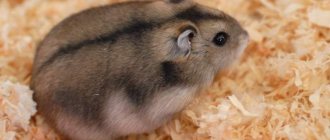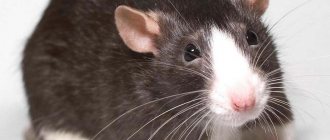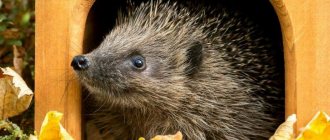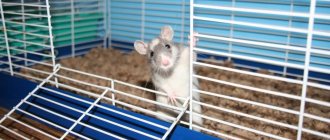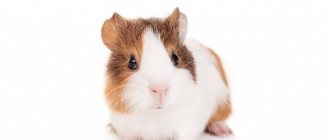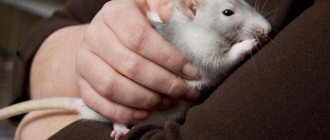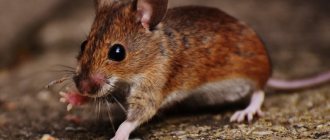Decorative rodents are tiny, cute animals with a good-natured character and funny habits. They do not take up much space and do not create a mess in the apartment; even a child can easily handle them. And in order not to get confused in the available variety and make the right choice, you need to find out in advance which rodents are better than others for home keeping.
Popular pet rodents
The order of rodents is the most numerous among mammals. However, not all of them are tamed by humans and are able to live with him side by side in the same room.
Species that are specially bred as domestic animals or have a long history of friendship with humans are more adapted to life in captivity than others.
In nature, degus live in communities
Chilean squirrel
Degu is a small South American rodent that looks like a jerboa. An adult reaches up to 30 cm in length, while weighing only 200-300 g. The coat is hard and dense, the color is brown-yellow or chestnut-gray. Average life expectancy is 6-8 years.
In the wild, degus live in communities, and therefore require a lot of attention at home. They are highly active, but lead a diurnal lifestyle.
Teeth grow throughout your life and require constant grinding. Special mineral stones, as well as dry branches of bushes and trees, will help with this.
REFERENCE! Degus have poor eyesight (they have trouble seeing into the distance), but excellent hearing and sense of smell.
Chipmunks are very unpretentious
Chipmunk
This rodent is easily distinguished from others by longitudinal stripes alternating in color on its back. The size of the animal depends on the specific species: the smallest is 5 cm in length and weighs 30 grams, the largest is 15 cm in length and about 130 grams in weight.
The chipmunk is unpretentious in care and food.
REFERENCE! The main disadvantage is that they do not get along well with each other from autumn to spring, and each animal will need an individual cage.
Gerbils are easy to tame and very clean.
Gerbil
Currently, there are more than 100 species of this animal, but only the Mongolian gerbil has been tamed. Size – from 5 to 20 cm in length, weight – from 15 to 200 g. A characteristic feature is a tail with a tassel at the end. Sand-colored fur coat.
Because In their natural environment, rodents live in families; it is better to take them in pairs for the home. They are clean, easy to tame, and amenable to training. They have an inquisitive and friendly character.
Rats are affectionate and playful
Decorative rat
If it were not for the long hairless tail, this rodent would have more fans. Unlike their wild relatives, domestic rats are very intelligent animals. Pets have inherited intelligence from their ancestors, which helps in learning and training. Rats are affectionate, playful, happy to sit on their owner’s shoulder and watch his actions.
They do not require a lot of space or expensive food. Extremely easy to care for and very clean. They behave quite quietly.
The only disadvantages that can be noted are the short lifespan (about 3 years) and the desire to try everything by heart.
Guinea pigs are peaceful
Guinea pig
A small (up to 1.5 kg), well-fed animal with floppy ears, large eyes and a wide muzzle. The pig is popular as a pet because of its attractive appearance, unpretentiousness, and peaceful nature. It is an ideal companion for children.
Rabbits live about 10 years
Decorative rabbit
This is a cute and funny animal, which is much easier to care for than a cat or dog.
They are trainable and can be taught to use the litter box. A walk on a harness across the lawns will bring great joy to the animal. It tolerates trips in a cage to the dacha and picnics well.
At home, you will need a cage of at least 70 cm, wood filler and hay. The latter serves as both food and bedding. The diet also includes grain mixtures and succulent feed.
Rabbits are sociable and love attention. These are affectionate and devoted comrades.
Life expectancy is 8-10 years.
Would you like to have a rabbit at home?
Chinchillas are highly trainable
Chinchilla
The body of the animal is covered with thick soft fur, because of which they were not so long ago on the verge of extinction. Coarse hairs grow on the tail. The animal is 22-38 cm in length (tail up to 17 cm), weighing 700-800 g. Life expectancy is longer than that of other rodents - up to 20 years.
REFERENCE! Female chinchillas are usually larger than males.
The chinchilla's skeleton is compressed in a vertical plane, so the pet can climb into the smallest crevices. The hind legs are twice as long as the front legs, allowing them to jump high.
These are energetic, active and emotional animals. They don't bite or scratch unnecessarily. Well trained.
Due to the absence of sweat and sebaceous glands, they do not have an unpleasant odor. It is enough to clean the litter and toilet once a week.
Valued for its silky, pleasant-to-touch coat, which is a pleasure to iron! Caring for her is not a hassle. Fur hygiene includes bathing in special fine sand. Fleas and ticks do not attack the dense undercoat of a rodent. Another plus is the absence of seasonal molting.
REFERENCE! Inside the ears there is a special membrane for taking sand baths.
For home keeping you will need a spacious and high cage with at least one shelf. Feeding once a day with special dry food.
Hamsters easily tolerate loneliness
Hamster
Perhaps the most popular domestic rodent due to its ease of care and unpretentiousness: it eats little, does not require attention to itself, and also has a lot of space.
At the same time, hamsters are nocturnal animals; they like to sleep during the day and do not respond to invitations to play. Quite aggressive, in the same cage with a relative they organize fierce fights.
It is difficult for them to get used to the hands of their owner and they often bite. Easily tolerates loneliness.
For maintenance you need a strong wire cage. It is recommended to let him run around the apartment in a walking ball, otherwise the hamster may spoil things and hide in a hard-to-reach corner.
The most common breeds are the Dzhungarik and the Syrian hamster. They live on average 2-3 years.
Jerboas are very mobile - they need a lot of space
Other rodents
In addition to the above, humans are trying to domesticate other representatives of the rodent order. For example:
- Decorative mice are an excellent option if you have limited living space and limited free time. They are tameable, active and playful, almost omnivorous. The pet can be placed either in a cage or in a glass terrarium. The main disadvantage is the specific smell that remains even after cleaning and washing the home.
- The common squirrel or veksha is a cute fluffy animal, but having one at home is tantamount to accomplishing a feat. Only individuals tamed at an early age are not aggressive. They are prone to mood swings and have an unpredictable character.
- The dormouse rodent comes in two varieties: terrestrial (mouse-like) and arboreal (squirrel-like). Both adapt well to life in captivity. Unlike squirrels, they are affectionate and friendly, but these animals cannot be called clean. They have a pungent odor.
- Jerboas are small animals with a long tail and well-developed hind legs. They are very mobile, and in small spaces they get sick from lack of physical activity. The pet’s “den” should not be covered with hay and sawdust - high humidity is harmful to the jerboa and it is prone to allergies. An animal needs access to clean, calcined sand to bathe.
You can add marmots, gophers, etc. to this list. What these animals have in common is that it is quite difficult to tame them. The “wild nature” of animals will manifest itself either in a pungent odor or in the unsociability of the pet. External cuteness can hide many behavioral problems, even if the rodent is purchased under the “pet” brand.
Rodents don't always live long
Hamsters
They are funny, but can show character - behave aggressively, even claw at the feeding hand. A bad mood is guaranteed when they are asleep if they are forcibly awakened. There are rodents with a pleasant character. Golden or Syrian hamsters are considered loners. If you add another to one animal, they can fight for several days. It is better to keep each one in a separate cage. Maintenance is easy, but the litter needs to be changed more often. Veterinarians recommend corn filler: it doesn’t create as much dust and doesn’t get into the eyes as small sawdust. Hamsters have a life cycle of about three years.
Rodent in the house: is it worth getting a pet?
When you decide to get a pet rodent, you need to carefully weigh the pros and cons of such a step.
Advantages
- Pleasant appearance: soft fur, expressive eyes, small paws.
- Unpretentiousness: pet rodents do not require a lot of space and private walks.
- Cost-effective: relatively inexpensive (compared to buying a purebred dog or cat), food is affordable and is consumed slowly.
- Convenience: Most pet rodents make quiet sounds and do not interfere with work or sleep.
- Variety of breeds and colors. You can take part in exhibitions with some rodents and engage in commercial breeding.
Flaws
- Low life expectancy. Many rodents live only 2-3 years. Exceptions: guinea pigs (6-8 years), chipmunks (10 or more years), rabbits and chinchillas (about 15).
- The need to sharpen due to their constant growth. To do this, pets are given mineral stones and tree branches, but the rodents can get into cables, interior items, clothes and shoes of the owner.
- Specific smell of excrement, need for frequent cleaning.
- Fragility of most representatives, timidity.
Mice
The average lifespan is 3 years. If what kind of rodents are most often kept in the home, then these are mice. And all thanks to its unpretentiousness and unpretentiousness. Their big advantage is their easy care. Mice are social creatures and live best in pairs or groups. For them, you can purchase a compact cage, not too large, especially for a single animal.
Which rodent is better to have in an apartment?
According to the size of the apartment, the pet living in it is chosen. Large rodents such as rabbits are not easy to keep in a small home. But rats, hamsters, gerbils and chipmunks will not notice the modesty of square meters.
It is worth considering your readiness for household chores. Even small animals need to regularly clean the toilet and change the bedding. Chinchillas and gerbils are cleaner than other rodents.
Hairless breeds of rodents: hairless rat, skinny guinea pig, etc. will reduce cleaning and help avoid allergies.
Maintenance cost
You also need to find out how expensive it is to maintain a particular animal. After all, equipping a terrarium for a turtle or an exotic lizard will cost a decent amount. And puppies and kittens are not cheap at all, but you also need to think about the costs of vaccination and possible treatment.
Aviary for chinchilla
Everything needs to be taken into account: necessary equipment, nutrition, treatment, care.
Which rodent is best to get for a private home?
Compact rodents take root better in small apartments. For example, decorative rats, once in a large house, can make an unwanted acquaintance with wild relatives with all the ensuing consequences. A miniature hamster will probably find a secluded corner from which it will not want to get out. The smaller the pet, the easier it is to lose it in the vastness of a private home, and the tempting attic, basement and closets can be fraught with potential danger for the rodent.
In the private sector they feel at ease:
- decorative rabbits,
- Guinea pigs,
- chinchillas.
The ability to walk freely is only beneficial in this case. To avoid losing your pet, it is better to walk with a harness.
Black and gray rat
The black rat is called a roof rat, an attic rat, or a ship rat. Activity at night. This is a less aggressive species than gray rats. The second name is gray barn.
This is the largest and most vicious species. She is able to displace the black one. Distinguished by strength, cunning, audacity, dexterity.
In the wild, rodents live near water. They fight rats using various methods:
- biological - cats and dogs are assistants;
- physical - with the help of rat traps, traps, traps;
- chemical - poisonous drugs;
- ultrasonic
Who do you meet more often?
RatsMice
Which rodent is best for a child?
When choosing a pet for a child, the following qualities of the pet will be prioritized:
- ease of care,
- friendly, non-aggressive character,
- sufficient life expectancy.
Introverted hamsters are not suitable for an active baby; they die very quickly and can cause moral trauma. Rabbits require special care; a child may not be able to cope with the assigned responsibility.
They get along well with children and are unpretentious:
- rats,
- Guinea pigs,
- chinchillas.
Guinea pig
The pet is very calm and good natured. Herbivorous animal, does not eat animal products. Long-lived rodent: age can reach five to eight years. You shouldn’t count on high intelligence - it’s afraid of everything, and is difficult to tame. They can be kept in pairs of the same sex - they are harmless and cute creatures. They make a wide variety of sounds - they purr in a good mood.
If you let them go for a walk, they freeze and look for shelter. They are constantly waiting for greenery - the animal will even refuse red apples in the hope of green ones. Guinea pigs need hay - as bedding and as a supplement to their diet. If you dream of an exhibition career, then the fur of rodents is wound on curlers - most of them do not mind. The fur then falls beautifully. It is strictly forbidden to cut your pets' hair, only pluck it.

